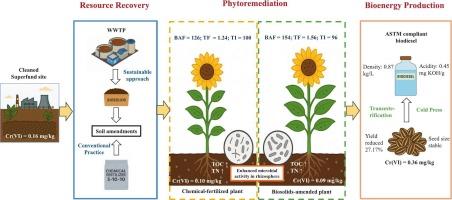Phytoremediation of low-concentration Cr(VI)-contaminated soil from a superfund site using sunflower (Helianthus annuus L.) with concurrent biodiesel production from harvested seeds
Q1 Environmental Science
引用次数: 0
Abstract
The purpose of this study was to evaluate the feasibility of using sunflower (Helianthus annuus L.) for simultaneous phytoremediation of low-level hexavalent chromium [Cr(VI)]-contaminated soil and biodiesel production. Soil was collected from a remediated superfund site where the residual Cr(VI) concentration was low (0.16 ± 0.04 mg/kg) due to prior cleanup, and controlled pot experiments were conducted under two amendment conditions—low-nitrogen chemical fertilizer and biosolids—to assess plant growth, Cr(VI) uptake, biodiesel quality, and microbial responses. In addition, bioaccumulation factor and translocation factor were assessed to evaluate the efficiency of chromium uptake and movement within the plant. Results showed that Cr(VI) was absorbed by the roots and translocated to shoots, leaves, and seeds, with both amendments achieving comparable phytoextraction efficiencies. Biosolids amendment significantly enhanced plant biomass compared to chemical fertilizer, while no visible phytotoxicity symptoms were observed, indicating that sunflower tolerated the low-level Cr(VI) contamination. Biodiesel extracted from the seeds met the American Society for Testing and Materials (ASTM) standards for acid value and density, confirming its potential as a renewable fuel. Moreover, microbial biomass carbon and nitrogen in the rhizosphere increased after phytoremediation, suggesting a beneficial role of soil microbes in supporting plant growth and remediation. Overall, this study demonstrates that integrating sunflower-based phytoremediation of low-level Cr(VI) with biodiesel production provides a sustainable and cost-effective strategy for addressing residual contamination while contributing to renewable energy generation.
⁎Corresponding author at: School of Civil, Environmental and Infrastructure Engineering, Mail Code 6603, Southern Illinois University, 1230 Lincoln Dr., Carbondale, Illinois 62901, USA.

向日葵对土壤低浓度Cr(VI)污染的植物修复研究
本研究的目的是评价向日葵(Helianthus annuus L.)同时修复低水平六价铬[Cr(VI)]污染土壤和生产生物柴油的可行性。选取修复后残留Cr(VI)浓度较低(0.16±0.04 mg/kg)的超级基金场地土壤,在低氮化肥和生物固体两种改良条件下进行对照盆栽试验,评估植物生长、Cr(VI)吸收、生物柴油质量和微生物反应。此外,还测定了生物积累因子和转运因子,以评价植物对铬的吸收和移动效率。结果表明,Cr(VI)被根吸收并转运到芽、叶和种子中,两种改进剂的提取效率相当。与化学肥料相比,生物固体添加剂显著提高了植物生物量,但未观察到明显的植物毒性症状,表明向日葵耐受低水平的Cr(VI)污染。从种子中提取的生物柴油符合美国材料测试协会(ASTM)的酸值和密度标准,证实了其作为可再生燃料的潜力。此外,植物修复后根际微生物生物量碳和氮增加,表明土壤微生物在支持植物生长和修复中发挥了有益的作用。总体而言,本研究表明,将向日葵植物修复低水平Cr(VI)与生物柴油生产相结合,为解决残留污染提供了一种可持续且具有成本效益的策略,同时有助于可再生能源的产生。通讯作者:南伊利诺伊大学土木、环境与基础设施工程学院,邮编6603,1230 Lincoln Dr, Carbondale, Illinois 62901, USA。
本文章由计算机程序翻译,如有差异,请以英文原文为准。
求助全文
约1分钟内获得全文
求助全文
来源期刊

Bioresource Technology Reports
Environmental Science-Environmental Engineering
CiteScore
7.20
自引率
0.00%
发文量
390
审稿时长
28 days
 求助内容:
求助内容: 应助结果提醒方式:
应助结果提醒方式:


